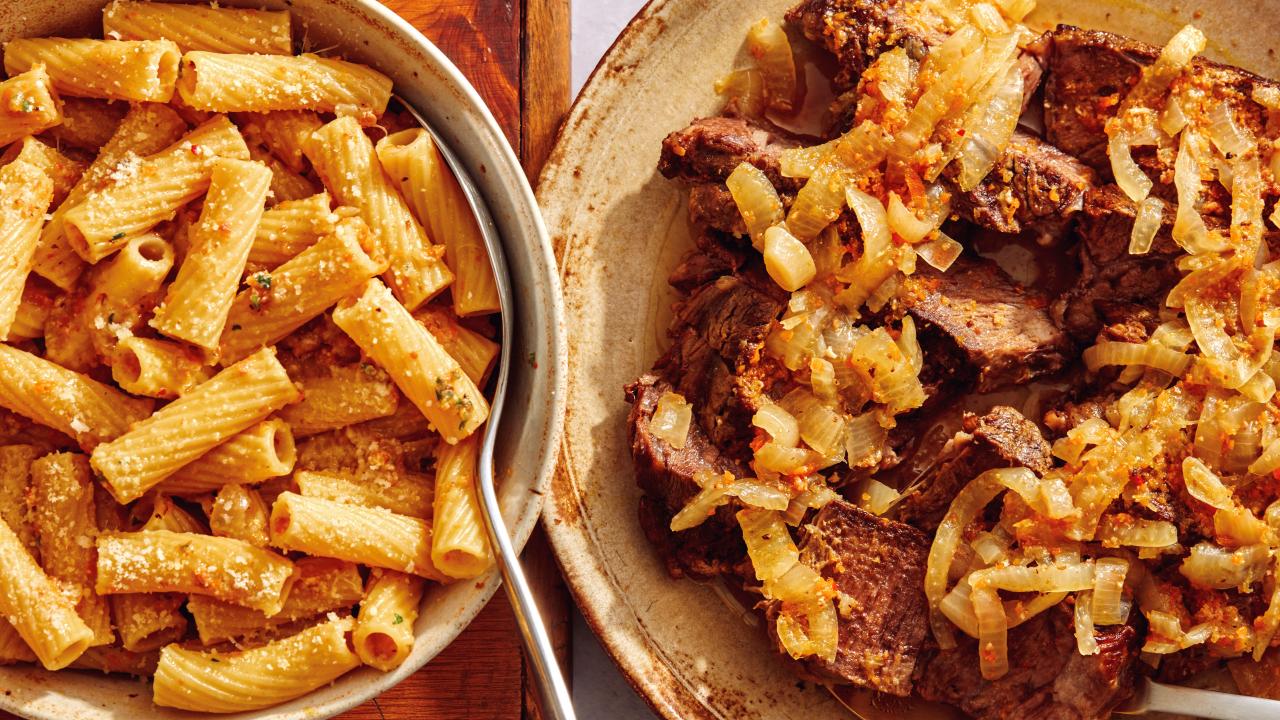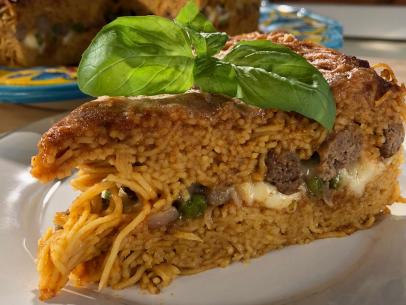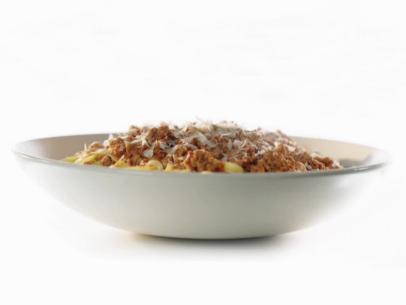Recipe courtesy of
Amy Stevenson
for
Food Network Kitchen
Recipe courtesy of
Amy Stevenson
for
Food Network Kitchen
Watch how to make this recipe.
Sugo alla Genovese
Getting reviews...
- Level: Easy
- Total: 4 hr
- Active: 40 min
- Yield: 6 to 8 servings
-
- Nutritional Analysis
- Per Serving
- Serving Size
- 1 of 8 servings
- Calories
- 796
- Total Fat
- 24 g
- Saturated Fat
- 9 g
- Carbohydrates
- 69 g
- Dietary Fiber
- 7 g
- Sugar
- 13 g
- Protein
- 71 g
- Cholesterol
- 176 mg
- Sodium
- 1493 mg
Onions, not tomatoes, are the star of this hearty, meaty ragù that’s often served in two courses: First as a sauce over pasta, then as a second course featuring the thinly sliced meat itself with a few side dishes like steamed vegetables and potatoes. Sugo means sauce in both Neapolitan and Genovese dialects, although you might also see this dish called pasta alla genovese, ragù alla genovese or even just la genovese. But despite the reference to Genoa in all its names this is a classic dish from Naples, possibly introduced there by sailors or merchants from Genoa around the 15th century. And since it originated before tomatoes were widely used in Italy its base is lots and lots of onions — an impressive pound-to-pound ratio of beef to onions in fact. While in Italy braises like this are often served as two courses, you can serve it just as a pasta sauce if you prefer. If serving as a sauce only, don’t tie the meat before cooking it, and then shred it into the sauce just before serving; you’ll get enough to sauce for 2 pounds of dried pasta. It also freezes very well if you don’t want to serve it all at once.
- Level: Easy
- Total: 4 hr
- Active: 40 min
- Yield: 6 to 8 servings
-
- Nutritional Analysis
- Per Serving
- Serving Size
- 1 of 8 servings
- Calories
- 796
- Total Fat
- 24 g
- Saturated Fat
- 9 g
- Carbohydrates
- 69 g
- Dietary Fiber
- 7 g
- Sugar
- 13 g
- Protein
- 71 g
- Cholesterol
- 176 mg
- Sodium
- 1493 mg
Ingredients
Directions
- Tie the beef crosswise with kitchen string at 2-inch intervals so it will keep its shape during cooking. Season all over with 1 teaspoon salt. Heat the olive oil in a large Dutch oven over medium heat. When the oil is hot, add the beef and sear well all over, 8 to 10 minutes. Transfer to a plate.
- Meanwhile, combine the pancetta, celery and carrot in a food processor and process to make an almost smooth paste. Once the beef is out of the pot, add the paste. Cook and stir until the fat is rendered and the paste has dried out, 3 to 4 minutes.
- Add the onions to the skillet and season with 1 teaspoon salt. Stir to combine with the paste and add the wine. Bring to a rapid simmer then add the bay leaves, pepper flakes and 1 cup water. Return to a simmer and nestle the beef in with the onions. Adjust the heat so the liquid simmers gently and cover the pot. The onions will give off juices and create more liquid as they cook. Check after 30 minutes; there should be liquid almost up to the top of the beef. If not, add up to 1/2 cup more water. Cook, covered, flipping the beef halfway through, until it’s so tender that a knife inserted in the center slips out with almost no resistance, a total of 2 1/2 to 3 1/2 hours. (A flatter and longer beef cut will take less time than a thicker one.)
- Once the beef is tender, transfer it to a cutting board and cover loosely with foil to keep it warm. Bring a large pot of salted water to boil for pasta.
- Bring the onion sauce to a boil, adjust the heat and simmer until thickened and reduced by about a third, about 5 minutes. Taste the sauce and season with salt if needed. Discard the bay leaves. Transfer about 2 1/2 cups of the sauce to a large skillet and bring to a simmer.
- Once the water boils, cook the pasta until al dente, a few minutes shy of the package directions. Drain, reserving 1/2 cup of the cooking water. Add the pasta to the simmering sauce. Sprinkle with the parsley and drizzle with a little olive oil. Toss to coat the pasta in the sauce, adding a little pasta water if it seems dry. Remove from the heat, sprinkle with the Parmesan and toss well. You can serve the pasta as a first course before the meat, or along with it.
- Untie the meat, slice it and transfer it to a platter. Top the meat with more sauce. Pass the pasta and any remaining sauce and extra Parmesan at the table.
Cook’s Note
To get deliciously melting onions, make sure to slice them thinly from top to bottom, as opposed to crosswise.


































